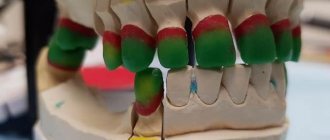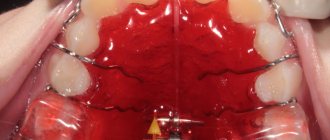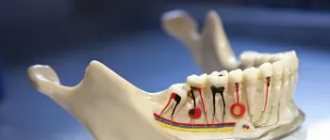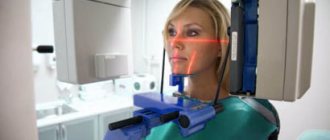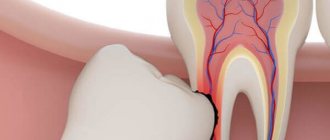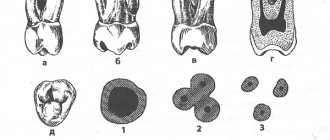7555
According to studies, the incidence of mesial occlusion with cross occlusion in children during primary and mixed dentition reaches 10-12%.
The anomaly is characterized by a narrowed upper jaw, narrow nasal passages, violation of proper occlusion, difficulty biting and chewing food and some other negative consequences.
Failure to correct a narrowed jaw can lead to disruption of the symmetry of the child’s face, pathological restructuring of the masticatory muscles, and disruption of the TMJ.
The most effective means of treating the anomaly are devices for palatal expansion. One such device, specifically adapted for use in children in mixed dentition, is the Marco Ross palatal expander.
General overview
The full name of the Ross apparatus is plate-type, non-removable, mechanically operating, single-jaw. The device consists of the following elements:
- Hyrex screw with guides on both sides. Serves to create an expanding force.
- Rings for temporary molars. Provide fixation of the device on the supporting teeth.
- Metal feet. They rest against temporary fangs, creating points of application of force to the dentition, additional to the rings.
- Plastic base (plate), consisting of two parts. Combines all components into a single design.
The device bears the name of its developer. It is made from a plaster model, molded according to an impression from the child’s upper jaw. Costs about 10,000 rubles.
The use of the device allows you to expand the upper jaw along the median seam by 10-13 mm, increase the length of the upper jaw arch, eliminate mesial occlusion, and achieve normalization of a number of other functions of the dentofacial apparatus in children aged 5-11 years.
Depending on the tasks being solved, the Ross apparatus can be modified, in particular, equipped with dental onlays.
Anomaly classification
Normally, the mandibular arch should be in the shape of a parabola, and the upper one should be an ellipse. However, according to the clinical manifestations, 4 forms of anomaly are observed, characterized by their own specific signs:
- Compression of the dentition (jaw) along its entire length. The defect is characterized by protrusion of the anterior section relative to the entire frontal region. In addition, the elements are arranged in a fan-shape, and the lateral incisors are placed close to the center.
- Narrowing of the anterior sector only. This anomaly is distinguished by the V-shaped appearance of this section of the row, in which the incisors, moving forward, are closely spaced and form a pointed angle.
- Uneven development . It is distinguished by the asymmetry of the dental radius, when its narrowing occurs only in individual segments. It differs from other forms of anomaly in the appearance of crowding of teeth exclusively in a certain area.
- Clenched jaw. A distinctive sign of pathology is compression of the dentition in the area of the molars/premolars, as well as a saddle-shaped jaw.
The pathological condition in this clinical situation is uneven and does not cover other parts of the jaw arch. This form of the defect is characterized by the wrong direction of growth and development of the lateral elements, which over time tilt towards the cheeks or tongue. - Trapezoidal dentition . The jaw arch resembles a trapezoid - flattened, with four corners. The incisors do not come forward, but are crowded. They are often observed to turn around their axis.
Important! Regardless of the form of the defect, over time its clinical picture only worsens, leading to aggravation of the condition and to an even stronger deviation in the position of the elements and compression of the jaw arches.
Many dentists consider parallel narrowing of the jaw arches as a separate (independent) pathology. Distortion of parameters is also diagnosed in cross bite, open deep bite, as well as with progenia or prognathia.
With such developmental anomalies, compression is regarded as a symptom that aggravates the underlying pathology of occlusion.
Indications for use
The optimal time to use the device is 6-8 years. However, depending on the clinical picture, this interval can be extended to 5-11 years.
Indications for the use of the Marco Ross apparatus are many pathological changes in the dentofacial apparatus caused by a narrow upper jaw:
- Cross mesial bite.
- Lack of space for permanent teeth in the anterior segment of the upper jaw. Lack of space causes permanent teeth to shift relative to the dental arch, either palatally (usually) or vestibularly, when they erupt.
- Speech impairment due to limited tongue movement.
- Mouth breathing due to narrow nasal passages.
- Excessive development of the lower jaw and its blocking by the upper teeth.
- Problems with biting and chewing food.
- Lack of physiological abrasion of primary canines, preventing correct occlusion.
- TMJ dysfunction due to mesial crossbite. Its signal can be headaches that are otherwise unexplained.
What devices does Nord's device belong to by purpose?
Visit here to view popular preventive orthodontic appliances.
At this address https://orto-info.ru/sistemyi-vyiravnivaniya-zubov/lechebno-profilakticheskie-apparatyi/vse-sekretyi-fnta.html all the most important things about the functional fixed telescopic device.
Operating principle of the device
The principle of operation of the Marco Ross apparatus does not differ from other devices used to expand the upper jaw along the median palatal suture.
The expansion force is created by the Hyrex screw. Its rotation causes expansion of the plastic base, which transmits the force from the screw to the dentition using rings and legs. The first ones are put on the primary molars, the second ones rest on the primary canines.
It takes several days to manufacture the device. Getting used to it takes about the same amount of time, during which diction may become impaired. After getting used to it, it recovers.
A special feature of the device is that the plastic base does not put pressure on the palate and alveolar processes, but only lightly touches them. This makes wearing the device more comfortable.
The device is practically invisible, due to the fact that the legs resting on the fangs are attached with a composite and not with rings.
The device is activated using a special key with a pin. The central part of the screw has holes located at an angle of 90°. The key is inserted with its pin into the hole and turned a quarter turn. One turn corresponds to moving the base plate screw by 0.25 mm.
The main subtlety of activation is that at the end of each turn of the key, the next hole appears where a pin can be inserted.
Activation is performed by the baby’s parents daily or at intervals of several days - in accordance with the scheme specified by the orthodontist.
You can use fast and slow expansion. Fast involves activating the screw every day, slow - after a few days.
It is believed that slow expansion provides a more stable result, however, it takes longer. Some experts recommend a combination of fast and slow expansion. For example, at the beginning of treatment, a slow expansion is carried out, and after a few weeks - a rapid one.
When using forced expansion, the active treatment period lasts about a month. In the next 0.5-1 year, the device is worn for retention purposes without activation.
Although the Marco Ross device does not directly affect the lower jaw, it does have an indirect effect. Normalizing the parameters of the upper jaw leads to the unlocking of the lower jaw and its adjustment to the upper one.
When wearing the device, special attention is paid to oral hygiene, more precisely, to the place of contact of the base plate with the palate , where food can be stuffed. It is best to clean it with an irrigator.
Jaw expansion in adult patients
Is it possible to widen the jaw of an adult patient or is this only available for children? This question often worries patients. The answer is yes, the jaw can be expanded for both adults and children. If we are talking about the expansion of the upper jaw, then the expansion at 16 years old and at 26 will not differ much. In both cases, jaw growth is complete and it is difficult to expand the jaws.
Why do we consider this topic relevant? Because a wide smile has become very fashionable. People expand their dentition with great persistence, and often to the detriment of their health. Here is a case from a consultation appointment in our orthodontic office.
The patient previously wore braces. A repeated visit a few years later is due to the appearance of a diastema and the fact that, according to the patient, “the teeth have floated.” Other errors in orthodontic treatment include signs of crossbite. It is interesting in this case that when asked if you widened your jaw to get a wide smile, the patient answered: “YES!”
The smile is beautiful and wide. But the upper teeth do not meet the lower teeth.
Just like in the child in the previous case, the bite is not functional. This is a buccal type of occlusion.
To properly understand the process of jaw expansion, we would like to provide several explanatory diagrams. So, when expanding the upper dentition, the optimal expansion is considered to be one in which the two jaw bones will diverge in the opposite direction, separating along the median suture (corpus movement).
However, it is not just the seam connection that prevents perfect movement. In addition to connecting to each other, the maxillary bones have a strong connection with the base of the skull and zygomatic bones. The entire complex of bones is tightly bound to each other and prevents expansion. Therefore, complications in the form of tilting of the teeth, instead of body movement, are possible.
If, nevertheless, it was possible to successfully expand the upper dentition, then the only side effect can be an malocclusion, which was discussed above. But with the lower jaw the situation is different.
The lower jaw is not only very dense and requires surgery to expand. The lower jaw provides us with the ability to chew, speak, and move. And all this thanks to the paired jaw joint.
Expanding the lower jaw means increasing the distance between the articular processes. Such movement will always lead to joint dysfunction. After all, the articular fossae with which the processes articulate will remain in the same positions.
It is worth measuring seven times before proceeding with the expansion of the lower jaw.
Installation process
The Marco Rosa apparatus has four elements that are used to fix it to the jaw. Two rings (left and right) that fit on the molars, and two legs (also left and right) that rest on the fangs.
Installation is performed in the following sequence:
- A week before installing the device, separating rubber bands (separation rings) are inserted between the supporting painter and adjacent teeth, which create a gap for installing metal rings on the painters. On the day of installation of the plates, these elements are removed before the start of the procedure.
- All teeth are cleaned with a rotating brush and toothpaste.
- Prepared cement is applied to the rings of the apparatus.
- The device is inserted into the mouth, the rings are put on the molars and pressed all the way with the instrument. The paws should be located on the occlusal surface of the canines. Excess cement is removed.
- The interdental spaces in the area where the rings are fixed are cleaned with thread.
- A composite is applied to the fangs at the point of their contact with the paws to fix the paws. Excess composite is removed.
- The junction is irradiated with light (to polymerize the composite).
This completes the installation of the plate..
In the video, watch how the Marco Ross apparatus is installed.
Advanced training for Dial-Dent specialists
The creator of the device for expanding the upper jaw is orthodontist Dr. Marko Rosa conducts lectures and seminars so that orthodontists learn all the features of the device and learn how to use it most effectively. Orthodontists "Dial-Dent" M.P. Sleptsova and O.N. The selector was trained by the author of the device.
Seminar Dr. Marco Rosa in Minsk at the Renaissance Minsk Hotel, October 2016
Orthodontists "Dial-Dent" O.N. Selector and M.P. Sleptsova at the seminar of Dr. Marco Rosa in Minsk at the Renaissance Minsk Hotel, October 2016
Orthodontists around the world have recognized the Marco Rosa apparatus as effective for orthodontic treatment of children and use it in their practice.
Make an appointment for a consultation by phone +7-499-110-18-01 or through the form on the website. You can ask questions about correcting your bite to the chief doctor of the clinic, Sergei Vladimirovich Tsukor, at
Features of treatment
Usually a narrowed jaw is combined with other dental anomalies and disorders - excessive development of the lower jaw, mouth breathing, pronunciation defects. Therefore, treatment with a Ross device can be especially effective in complex treatment.
In particular, in addition to the device it is desirable:
- the use of a face mask - an extra-oral structure, which, thanks to the chin pad, stops the development of the lower jaw;
- with mouth breathing, it is advisable to participate in the treatment of an ENT doctor. He must monitor the process of normalization of breathing;
- Correction of speech and swallowing is recommended with the participation of a speech therapist and myofunctional therapist. Their task is to normalize the tone of the facial and chewing muscles, correct the pressure of the tongue on the teeth, and control swallowing.
Only with such joint efforts can we ensure correction of all the adverse consequences of a narrowed jaw.
Will braces be needed?
Before starting treatment with the Marco Ross apparatus, it is impossible to say for sure whether further treatment with braces will be needed or not. This depends on the results of correction of disorders and the direction of development of the child’s dental apparatus.
In some cases, if the anomaly is not completely eliminated, braces will be required. In other circumstances, when the violations are completely eliminated, such a need does not arise.
But even if braces are used, treatment with them after correction with the Marco Ross apparatus will be much faster and easier than without it.
In addition, refusal to treat a narrowed upper jaw in childhood can create a situation in which an adult with fully formed teeth will need surgical intervention and the cost of the issue will be many times higher. If possible, it is better to avoid this.
What does the Bruxogard trainer look like and what is its purpose?
This publication provides instructions for using the TMJ joint splint.
Here https://orto-info.ru/sistemyi-vyiravnivaniya-zubov/lechebno-profilakticheskie-apparatyi/ispolzovanie-bidermana.html all the most important things about the Biderman apparatus.
Reviews
Parents should never stop using the Marco Ross expander, as this is the fastest and most effective way to eliminate jaw narrowing in a temporary dentition. If you and your child had to use this technique, tell us about its results. The feedback form is at the bottom of the page.
If you find an error, please select a piece of text and press Ctrl+Enter.
Tags devices: bite correction
Did you like the article? stay tuned
Previous article
Instructions for use of the anesthetic Scandonest in pediatric and adult dentistry
Next article
Purpose of the Coffin spring in orthodontic appliances
All the pros and cons of the technique
The Marco Ross device demonstrates almost one hundred percent successful results due to a number of features:
- High efficiency due to the fact that expansion occurs along the unfused median palatal suture.
- Complexity of impact. Along with the expansion of the jaw, the symmetry and aesthetics of the face are restored, the nasal passages are expanded (nasal breathing becomes easier), speech and swallowing are normalized, and mesial occlusion is eliminated.
- Short wearing period when using rapid expansion.
- Inconspicuous when worn.
- Elimination of treatment with braces or, in extreme cases, its significant relief.
- Easy ability to set the expansion rate (the screw can be turned to a larger or smaller angle, daily or intermittently).
- Possibility of use in primary and mixed dentition , when the correction of any dental anomalies is most effective.
- Simplicity and elegance of the design , bright color of the base plates, attractive to the child (creates motivation and eliminates the baby’s anxiety).
The only disadvantages include discomfort after activation and the need for long-term retention. But these features are characteristic of all orthodontic devices without exception.

